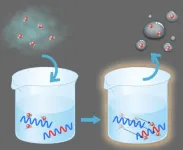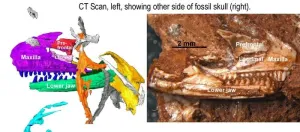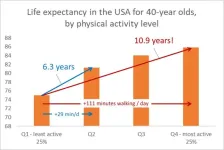(Press-News.org)
As we age, our cognitive and motor functions deteriorate, which in turn affects our independence and overall quality of life. Research efforts to ameliorate or even completely abolish this have given rise to technologies that show a lot of promise.
Among these is non-invasive brain stimulation: a term encompassing a set of techniques that can affect brain functions externally and noninvasively, without the need for surgery or implants. One such promising technique, in particular, is anodal transcranial direct current stimulation (atDCS), which uses a constant, low electrical current delivered via electrodes on the scalp to modulate neuronal activity.
However, studies exploring atDCS have produced inconsistent results, which has prompted researchers to explore why some people benefit from atDCS while others don’t. The problem seems to lie in our understanding of factors that may influence responsiveness to brain stimulation, leading to responders and non-responders; among these, age has been suggested as one important factor.
Some studies suggest further factors such as baseline behavioral abilities and previous training might be important considerations, but an interplay of these factors with behavior has not been determined in detail, pointing to the need of refined predictive models of the effects of atDCS.
Now, scientists led by Friedhelm Hummel at EPFL have identified an important factor affecting an individual’s responsiveness to atDCS. The team looked at how native learning abilities determine the effect of brain stimulation applied while learning a motor task. Their findings suggests that individuals with less efficient learning mechanisms benefit more from stimulation, while those with optimal learning strategies might experience negative effects.
The researchers recruited 40 participants: 20 middle-aged adults (50-65 years old) and 20 older adults (over 65). Each group was further divided into those receiving active atDCS and those receiving placebo stimulation.
Over ten days, participants practiced a finger-tapping task designed to study motor sequence learning at home while receiving atDCS. The task involved replicating a numerical sequence using a keypad, trying to be as fast and as accurate as possible.
The team then used a machine-learning model trained on a public dataset to classify participants as either “optimal” or “suboptimal” learners, based on their initial performance. This model aimed to predict who would benefit from atDCS, based on their ability to integrate information about the task efficiently early during training
The study found that suboptimal learners, who were seemingly less efficient at internalizing the task at the early stages of learning, experienced an accelerated accuracy improvement while performing the task when receiving atDCS. This effect was not limited to people of a certain age (e.g., older adults), with suboptimal learners being found among younger individuals as well.
In contrast, participants with optimal learning strategies, regardless of age, even showed a negative trend in performance when receiving atDCS. This difference suggests that brain stimulation is more beneficial for individuals who initially struggle with motor tasks. As such, atDCS seems to possess a restorative rather than an enhancing quality, with important implications for rehabilitation.
“By leveraging different methods in Machine learning, we were able to untangle the influence of different factors on the individual effects of brain stimulation,” says Pablo Maceira, the study’s first author. “This will pave the way to maximize the effects of brain stimulation in individual subjects and patients.”
The study implies that, in the long run, personalized brain stimulation protocols will be developed to maximize benefits based on an individual’s specific needs, rather than a common trait such as age. This approach could lead to more effective brain stimulation-based interventions, targeting specific mechanisms supporting learning, especially in the view of neurorehabilitation, for which the main basis is the re-learning of lost skills due to a brain lesion (e.g., after a stroke or a traumatic brain injury).
“In the future, clinicians could apply a more advanced version of our algorithm to determine whether a patient will benefit from a brain stimulation-based therapy, to enhance the effects of neurorehabilitation and personalize treatment,” says Hummel.
Other contributors
University of Geneva
University of Applied Sciences Western Switzerland (HES-SO)
NIH National Institute of Neurological Disorders and Stroke
Reference
Maceira-Elvira, P., Popa, T., Schmid, A. C., Cadic-Melchior, A., Müller, H., Schaer, R., Cohen, L. G., & Hummel, F. C. (2024). Native learning ability and not age determines the effects of brain stimulation. npj Science of Learning 27 November 2024. DOI: 10.1038/s41539-024-00278-y
END
Harvesting water from the air and decreasing humidity are crucial to realizing a more comfortable life for humanity. Water-adsorption polymers have been playing a key part in atmospheric water harvesting and desiccant air conditioning, but desorption so that the polymers can be efficiently reused has been an issue. Now, Osaka Metropolitan University researchers have found a way to make desorption of these polymers more efficient.
Usually, heat of around 100°C is required to desorb these polymers, but Graduate School of Engineering student Daisuke Ikegawa, Assistant Professor Arisa Fukatsu, ...
A large new population study of men over 45 indicates insulin resistance may be an important risk factor for the development of the world’s most common heart valve disease – aortic stenosis (AS).
Published today in the peer-reviewed journal Annals of Medicine, the findings are believed to be the first to highlight this previously unrecognised risk factor for the disease.
It is hoped that by demonstrating this link between AS and insulin resistance – when cells fail to respond effectively to insulin and the body makes more than necessary to maintain normal glucose ...
Effective immunity hinges on the ability to sense infection and cellular transformation. In humans, there is a specialised molecule on the surface of cells termed MR1. MR1 allows sensing of certain small molecule metabolites derived from cellular and microbial sources; however, the breadth of metabolite sensing is unclear.
Published in PNAS, researchers at the Monash University Biomedicine Discovery Institute have identified a form of Vitamin B6 bound to MR1 as a means of engaging tumour-reactive immune cells. The work involved an international collaborative team co-led by researchers from the University of Melbourne.
According ...
A collaborative effort by the research groups of Professor Haruhiko Fuwa from Chuo University and Professor Masashi Tsuda from Kochi University has culminated in the structure elucidation and total synthesis of anticancer marine natural products, iriomoteolide-1a and -1b. These natural products were originally isolated from the marine dinoflagellate collected off the Iriomote Island, Okinawa, Japan.
Because of its potent anticancer activity, iriomoteolide-1a is an intriguing natural product that attract immense attention from the chemical community around the globe. ...
A storeroom specimen that changed the origins of modern lizards by millions of years has had its identity confirmed.
The tiny skeleton, unearthed from Triassic-aged rocks in a quarry near Bristol, is at least 205 million years old and the oldest modern-type lizard on record.
Recently, the University of Bristol team’s findings came under question, but fresh analysis, published today in Royal Society Open Science, proves that the fossil is related to modern anguimorphs such as anguids and monitors. The discovery ...
If everyone in the United States population was as active as the top 25 per cent, individuals over the age of 40 could add five years to their life, according to a new study led by Griffith University researchers.
Physical activity has long been known to be good for health, however estimates have varied regarding how much benefit could be gained from a defined amount of activity, both for individuals and for populations.
This latest study used accelerometry to gain an accurate view of the population’s physical activity levels instead of relying on survey responses as per other studies, and found the benefits were around twice as strong ...
Plants need light to grow, but too much light can induce damage to the photosynthetic complex known as photosystem II. It is known that plants adapted to growing under full sun repair this light-induced damage more. But this repair activity slows down in colder temperatures. An Osaka Metropolitan University-led international research team has now found some clues to how plants survive in colder regions.
Graduate School of Science Associate Professor Riichi Oguchi and colleagues from Australia, Austria, and Japan grew Arabidopsis thaliana (commonly ...
Public health recommendations generally suggest drinking eight cups of water a day. And many people just assume it’s healthy to drink plenty of water.
Now researchers at UC San Francisco have taken a systematic look at the available evidence. They concluded that drinking enough water can help with weight loss and prevent kidney stones, as well as migraines, urinary tract infections and low blood pressure.
“For such a ubiquitous and simple intervention, the evidence hasn’t been clear and the benefits were not well-established, so we wanted to take a closer look,” said senior and corresponding author Benjamin Breyer, MD, MAS, the Taube ...
Men with cardiovascular disease risk factors, including obesity, face brain health decline a decade earlier—from their mid 50s to mid 70s—than similarly affected women who are most susceptible from their mid 60s to mid 70s, suggest the findings of a long term study, published online in the Journal of Neurology Neurosurgery & Psychiatry.
The most vulnerable regions of the brain are those involved in processing auditory information, aspects of visual perception, emotional processing and memory, with ...
An irregular sleep-wake cycle is associated with a heightened risk of major cardiovascular events, such as heart attack and stroke, even for those who clock up the recommended nightly hours of shut-eye, finds research published online in the Journal of Epidemiology & Community Health.
Most studies looking at the impact of sleep on health have focused on sleep length and less is known about the impact of sleep patterns, in particular the impact of irregular sleep—defined as variations in the time a person goes to sleep and wakes up.
To explore this further, the researchers drew on 72,269 people aged 40 to 79, taking part in the UK ...




